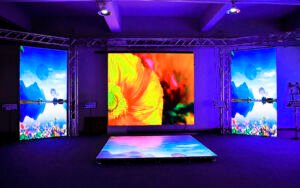9 points for comparison Between Synchronous and Asynchronous LED Displays

9 points for comparison Between Synchronous and Asynchronous LED Displays
Before clarifying the 9 points for comparison Between Synchronous and Asynchronous LED Displays We will take a simple overview of how synchronous and asynchronous systems work.
Synchronous LED-Display Control System.
The synchronized LED control system allows the display to show exactly what the computer displays, This display system has relevant control software, receiving and sending cards to get excellent results, You will install the receiving card on the screen while the sending card is on the PC.
In any case, you can use the computer software to edit the program and send it through the communication cards to transfer the info onto the screen for broadcasting, You will need a computer for the display’s proper working since the broadcast would switch off without a computer.
Thus, synchronous LED display control systems are ideal for real-time information, notices, adverts, text, pictures, and video broadcasts, It suits outdoor and indoor full-color screens The system controls the device’s working mode by mapping the information from the computer monitor to the screen in real-time.
Moreover, it has an update rate of over 60 frames per second, making it suitable for multimedia adverts since it works well with multi-grayscale colors, It is a standard option in special or creative design LED screens, large outdoor & indoor LED displays, rental event marketing displays, and 4K LED displays. Common applications include stage performances, exhibitions, cinema, conferences, and airports.
How Synchronous LED Display Transmission Works.
It utilizes different clocking lines in uses where the distance from the data communications equipment to the data terminal system is short, In the meantime, it features clocking electrical equipment at the receiving and transmitting point to allow it to synchronize data transmission.
Synchronously communicating devices utilize different clocking channels, In other words, it uses data blocks as communication units by attaching specific bits or characters to the data block’s end and start-point to mark where it finishes and starts. You can also attach a check sequence like a 32-bit or 16-bit check code to the data block for controlling errors.
Defining the time regulation is necessary since time intervals between synchronous data blocks remain fixed, The clock signal can maintain sync between the receiver and transmitter, allowing the receiver to utilize the signal to process incoming data within each bit-time.
In any case, the falling or rising edge can trigger the clock signal pulse process, If the receiver and transmitter are nearby, the bandwidth stays relatively high, making it more expensive and difficult to implement & design the control system, Thus, you can use embedded timing as a substitute for internal clock synchronization.
What is a Sync LED-Screen Control System?

9 points for comparison Between Synchronous and Asynchronous LED Displays – Synchronous system
An asynchronous LED screen control system has the opposite features of a synchronous one, The control system does not need a monitor to work with the screens all the time because it has a sending card and a memory function, In general, it features an array of functions, low prices, and simple operations.
The most critical function is controlling the screen content according to the area But the display does not require synchronizing from the computer monitor, In simple terms, the LED display will broadcast even when you turn off the computer, But the control card has a storage capacity that might limit the info it broadcasts.
Thus, it suits applications that do not require real-time broadcasts, The system comes in a cabinet that enables the user to send the data via the sending card using the monitor via a USB thumb drive, 3G Wi-Fi, SD card, or Ethernet cable, It instantly uploads the content onto the sending card’s memory and transfers it to the broadcast screens.
However, it is vital to select an industrial-certified Wi-Fi router within 10 meters distance instead of other choices like Ethernet cables, Other options like 3G and 4G connections will help solve the distance limit challenges, The maximum resolution load level for sync LED display systems must be lower than 23,000 pixels.
Thus, the control system suits high-speed applications, small LED screens, single-color LED sign boards, and small spaces functions, They involve shopping malls, building walls, plazas, Natural Parks, and pole billboards.
How Asynchronous Transmission Works?

9 points for comparison Between Synchronous and Asynchronous LED Displays – Synchronous system
Two bits combine into one to ease sync data communication, which starts at the ‘0’ bit, rising to the ‘1’ bit. The ‘1’ bit can halt communication while the ‘0’ bit starts the control display system, But the two-byte communication can incur time delays since the receiver and transmitter work at different clock frequencies.
Asynchronous systems utilize one character as the data transfer unit, The character features a stop and a start bit to indicate the end and beginning to enable data sync in sync broadcasts, The time interval can be variable since sync characters’ time relationship is not strict.
The system awaits the next signal once it processes data in one signal piece but switches to the idle state when it does not receive data, Using a constant negative voltage, you can represent the information in its control system, When a new character arrives, the system detects the start bit to initiate the edge transition.
In general, edge transition involves converting voltage to positive from negative to alert the control system of the new information it receives, Each character or data block has a single parity bit and, at most, eight data bits that the stop and start bits frame.
The parity bit provides limited error correction in sync communication, The receiver and transmitter lock tick at a similar nominal rate to detect the new data appearance and samples up to 11 bits in each incoming data block.
For more information’s about EGYLED Projects, Click here.
9 points for comparison Between Synchronous and Asynchronous LED Displays .
Speed:
The speed at which the communication transmits data is key in differentiating between sync and sync systems, Asynchronous communication is comparatively slower than synchronous transmission, The explanation is that sync transmission features a much higher traffic load time.
But the difference in speed might be hard to notice in devices with small data amounts and low-speed transmission, The lower speed in syncs broadcasts might challenge transmitting large data, Hence, it is unsuitable for high-speed applications that need large data transfer, The process of transmitting the start and stop characters makes Sync slow down.
Cost:
Asynchronous data bits broadcast costs more than synchronous communication, Nonetheless, syncs broadcasts are simple, while sync signals are somewhat complicated, Thus, asynchronous is the typical option for overall cost-effective data transmission methods.
Storage:
Sync broadcast requires a local buffer storage option from the start of the transmission to the reception point, This step allows the system to construct the data blocks, On the other hand, sync data communication does not need a storage option at the end of the terminal.
Form of Data:
One of the 9 points for comparison Between Synchronous and Asynchronous LED Displays, Sync data transmission communicates info in bytes or character forms, while sync broadcasts transmit via frames or blocks.
Transmission Method:
Sync data transmission occurs at high speed since it uses data blocks, but syncs communication transmits data slower since it submits it character by character, Besides, syncs data communication uses hardware to transmit the info, while sync communication uses software and hardware.
Time Interval:
One of the 9 points for comparison Between Synchronous and Asynchronous LED Displays, Synchronous transmission features a constant time interval between two consecutive data signals, It has no data gap since it has a common clock pulse during transmission.
Meanwhile, syncs broadcasts have random time intervals between two consecutive signals, It has a data bytes gap since it features end bits and start bits in the middle of the actual data transmission.
Asynchronous Programming vs. Synchronous Programming.

9 points for comparison Between Synchronous and Asynchronous LED Displays
Asynchronous programming involves event broadcasts independent of the program control system flow, It is prevalent in events like program-instigated actions and signal arrival and occurs concurrently through the program execution process without blocking or waiting to update the results.
The process involves asynchronous output & input as a latter case example, as it lets the program command network or storage devices to service the request while the PC executes the broadcast, Therefore, it allows parallel computing for flexibility.
Another excellent instance of asynchrony could be a programming interface that offers subroutines that provide a promise or future representing the ongoing process, Thus, synchronous reactive programming involves programming paradigm languages to make equal programming abstractions, such as sync abstractions for digital circuits.
You can design synchronous circuits at a high abstraction level, but it neglects the electronic transistors’ timing features, Each circuit gate possibly computes its results simultaneously, with each wire transmitting its signal instantly, The circuit clocks at every clock tick to compute instant output values and new memory cells values from the current and input values.
When to Use Sync LED System.
Asynchronous control systems are more suitable for independent applications where it is critical, For example, its systems suit development projects that have large iteration numbers, It can maintain simultaneous data development since its working process does not feature a fixed sequence.
Generally, sync planning best suits functions like responsive UI, like a shopping application requiring a larger font size for orders the user pulls up, It will enable simultaneous history loading and font size update instead of loading for some time.
When to Use Sync LED System.
On the other hand, synchronous LED control systems are fairly straightforward, Unlike asynchronous control systems that are relatively complex, they feature difficult coding and can overcomplicate the process.
For more information’s about EGYLED Products, Click here.

